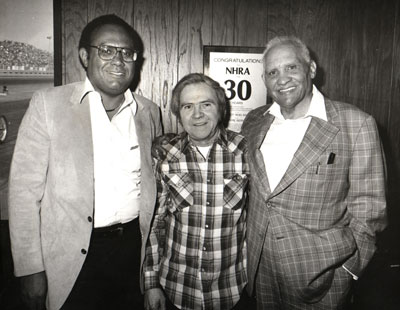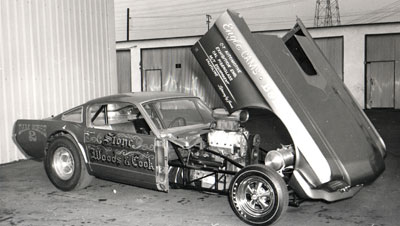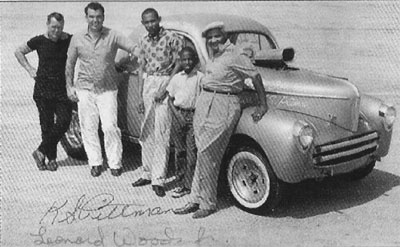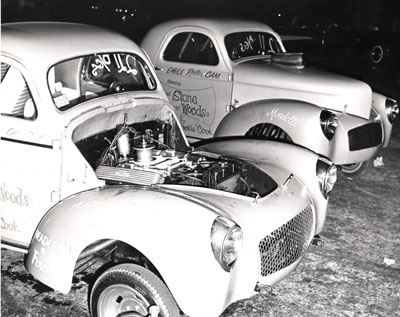

Stone, Woods & Cook: From the inside
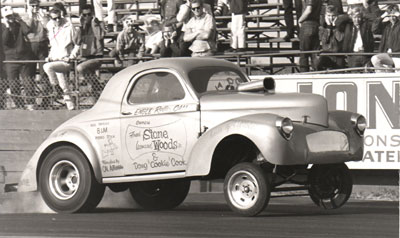 |
|
|
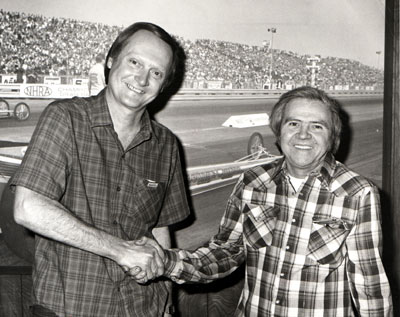 |
|
|
Within 30 minutes of posting the final results of our Favorite Race Car Ever poll Friday, I got two phone calls: one from Mike Cook, son of Stone, Woods & Cook pilot Doug Cook, and the second from
Both were literally over the moon that you all displayed such love for a very important part of their lives and wanted to fill in some of the blanks in the story and share their memories of that magical era.
The second-generation Cook, who today is heavily involved in land-speed racing at Bonneville and El Mirage, had been following the progression of the polls but had been at Bonneville recently and was only just tipped off about the final round.
"I know the popularity of the car -- we sell T-shirts and hats to people all over the world -- but when you’re so close to it, you don’t realize how big it is until something like this happens," he said. "We've been watching the poll – I have a whole notebook page full of the tallying as it went on – and I couldn't wait for you to get back from Indy [to close the voting]. We were hoping we could win, but because they still run [the Winged Express in exhibitions] it’s still very popular. I figured we could beat them but wasn't 100 percent sure because some of the people who followed that era aren’t really computer literate. I just wanted to thank you for putting together the poll. My family, all of us, we really appreciate it."
Woods, 62, the son of team co-founder Fred Woods and for years also an important part of the team, was equally thrilled. "I'm really elated; I feel like I just won Indy," he said. "What a great, great tribute to drag racers. Looking at all those cars brings back great memories. I'm sure my dad and a lot of people are smiling down on it.
"We've had so much fun with the voting; I can't tell you all of the people who have called," said Woods, who has owned and operated Chino Hills Ford, just a few miles from NHRA HQ, since 1982. "I even called Fred Stone's widow and told her about it, and she was very excited."
While Woods took a bow for the win, he did it with acknowledgements to many.
"The Stone-Woods-Cook car and whatever accolades it won are really a testimony to that particular class and that era and the competition that went on," he told me. "I talked with [fellow former A/Gas Supercharged legend] Junior Thompson and told him we needed his vote because Stone, Woods & Cook would not be where it is if we hadn't been racing him and the other cars. That's what made the class and helped make the car famous.
"There were just so many wonderful cars in the poll, and the Freight Train was always one of my favorites, as was the Winged Express," added Woods, whose son, Tim III, races in NASCAR West with engines built by Freight Train owner John Peters and his son, Brad. "They were all marvelous competitors, and I feel blessed to have seen all of those cars run. This poll's really got a buzz going; thank you for including us in it."
The Woods family also remains good friends with the Cook family. The younger Cook, 53, who is restoring the Dark Horse 2 Mustang Funny Car and still has the '37 Chevy in which his dad began his racing career – in fact, his son, Mike Jr. got married in it – runs Cook Motorsports in Norco, Calif., and oversees the racing efforts of his son, who drives a "Cook-blue" highboy roadster built by his dad and grandfather that recently set class records and, like his dad, is a member of the Bonneville and El Mirage 200-mph clubs.
After Doug Cook was badly injured in a top-end flip in the Dark Horse 2, he and Mike actually worked on the Funny Car of onetime rival "Big John" Mazmanian, then went to Bonneville, where Mike ran 295 mph against a 255-mph record with a Pat Foster-built car and had the first stock-bodied car, an Avanti, to run 200 at El Mirage.
"My dad and I were very close, and when he passed, I went into a tailspin for about six or seven months," Cook recalled. "He was more than my dad; he was my best friend, and sometimes, it felt like he was my kid. My dad was a simple man; he was so humble that he'd be embarrassed over the results of all of this. When I'd have him sign autographs at the races, it was like a little kid getting his first kiss. My parents were divorced, so my dad would pick me up on the way to
"When I retired [Swindler A] in 1982, Hot Rod magazine put it on its center spread and called it 'the most famous drag car of all time.' We knew it was still popular, but yours was a big poll. This is all very overwhelming to our whole family."
Woods was born Timothy Leonard Woods Jr., but he went by Leonard Woods Jr., and it was Leonard's name that was on the doors of the Willys, not his dad's.
"My dad liked it as a family sport, a team sport; it was something that he and I could do together," said Woods, who began working on the team car as a teenager while attending boarding school at St. John Bosco High in Bellflower, Calif. "I think he felt the need to put my name on it and as a hook to keep me interested in such a wholesome sport, plus he was a little concerned with the liability his construction company might face if something happened. He was very concerned with spectators and safety, and with some of the tracks we ran on and those cars running at the speed they were with high centers of gravity and the tires and engines of the times, they were a handful to drive."
His father's construction company was at the time the largest minority-owned construction company west of the Mississippi and second largest in the United States, with as many as 200 employees and 40-plus jobs going at any time, varying from new construction to building subdivisions and apartments all over Southern California and remodeling.
"I went to every race I could that didn't interfere with school, and when we raced locally in
"In 1964, we had 53 race dates between April and October, as ran as many as three or four times a week," he said. "We'd run round-robin against George Montgomery, Junior Thompson, and K.S. Pittman, and later 'Big John' sometimes substituted for Junior. K.S. Pittman was a fierce, fierce, fierce competitor, and George Montgomery was a genius with race cars. Junior Thompson was very competitive, and 'Big John' Mazmanian came out and jumped right in the middle of it. It was a fun time; I can’t even begin to tell you how much fun we had."
I asked Woods to share with us his remembrances and thoughts about each member of the fabled team.
"My dad loved being a part of it, but he was more of a background kind of person. He wanted to see the team succeed. My dad was the coordinator and oversaw the financial end of it. He was great at getting the heads done and having spare parts and rods and pistons, all of that stuff that we needed to keep the car running; we didn't have a hauler with three spare engines.
|
|
|
|
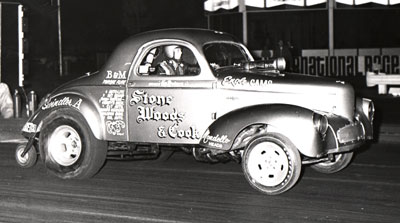 |
"Fred Stone worked with my dad at the construction company, where he was a very successful manager. Stone was a promoter, a very friendly guy; no one was a stranger to him. He was just an outgoing, gregarious kind of guy. He loved those cars and loved for them to be polished and detailed a certain w ay. He loved the competition and liked to stir the pot a little bit, in a friendly kind of way. He was a visionary in some ways because he spent an awful lot of his money on the car but promoted the car in such a way that he could make his money back. He formulated a spirited kind of thing that got the cam grinders and other equipment manufacturers involved, and away we went. He went at it from a very professional standpoint. He promoted a deal with Revell to get the car made as a model, and it’s still their most popular model ever, with over three million sold.
"Doug Cook was a great human being; everyone loved him, and everyone was happy to see him driving for us because he had worked so hard for so long. When my dad and Fred first formed the team and we won the '61 Winternationals with K.S. Pittman driving, Doug Cook was driving a Willys for Howards Cams in C/Gas. We were running B/Gas, but Pittman also had his own car in C/Gas, and it got to be a bit of a conflict, so we teamed with Cook at the end of the Winternationals.
"My dad was particularly impressed with Doug when he drove for Howards Cams; he did a lot with a little. It was perfect fit. He was a great driver and just a marvelous crew chief; he loved to race and to work on the car.
"As a youngster, I studied all of the classes and was interested in the physics of it all, keeping track of things like cubic inches and compression ratios and overdrives. I kept good notes of what jet we ran, what the blower overdrive was, what gear ratio we ran. We were capable of making changes to the car on the fly to get the car running good no matter what the conditions.
"We had a pretty decent nucleus of parts, and vendors like Engle Cams, B&M Hydro, Hilborn injection, and Gene Adams were particularly helpful with technical information because we were running Oldsmobiles when most everyone else was running Chevys.
"The team was a marriage made in heaven. We never had a bitter moment, win, lose, or draw. If we got beat, we went home and worked harder to try to come up with a new combination."
Based on the number of e-mails I received, many people were not aware that Stone and the Woodses were black -- a fact that would barely raise an eyebrow today -- and back then, especially with Cook's addition to the team making it an interracial team, it was an item of some concern.
Dick Gazan, who occasionally crewed for the team in the early 1960s, remembered, "Tim couldn't get motel rooms in Indy due to his race and had to rent a house in the black neighborhood to have a place to stay. And if you were a racer stuck for a place to sleep, you were always welcome. I don't think there is a man in drag racing that deserves more respect than Tim. When most of the country was still segregated, Tim ran an integrated team and even hired me, a young Jewish kid from
"Drag racers are a warm group, but there were places where we couldn’t go, but by and large we had a great experience," said Woods. "The fans and promoters welcomed us, and we never had much of a problem. They wanted to see the car run and what it could do and run as good as we said we could, and could we beat their local favorite. They key was, would they come and see you?"
Woods jokingly remembers that there was one place the team always felt a little less welcome:
"In
Woods also was sure to set the record straight that although
The rivalry lives on, I guess.
And so do the memories. Woods, who earned his master's degree at Notre Dame and worked for Ford for 13 years before he bought his dealership, remains a big car guy in his own right with his successful dealership, and it doesn't take much to get him reminiscing about the 1960s.
"I was blessed to be a part of it," he says simply.
And so, by extension, are all of us.
One of the great things about the Internet is that, other than your monthly connection fee, it's basically free. In general, there are no subscription costs to read a vast amount of interesting material, which means that for writers like me of columns like this, it exposes our work to wide audiences who might not subscribe to our print publications.
It also means that guys like me can hear from people who might have lost touch with NHRA but not the racing world, people who wrote the history long before I dig it up, polish it, and share it with you all. In the year-plus that I've been writing this column, it has put me in touch with a lot of famous racers, some of whom had hung up their helmets before I started writing much more than my ABCs, people whom I thought I would never have the chance to meet or interview.
And, like Woods, I feel very blessed, for the community we have and for the opportunity to serve it through this column.




















































